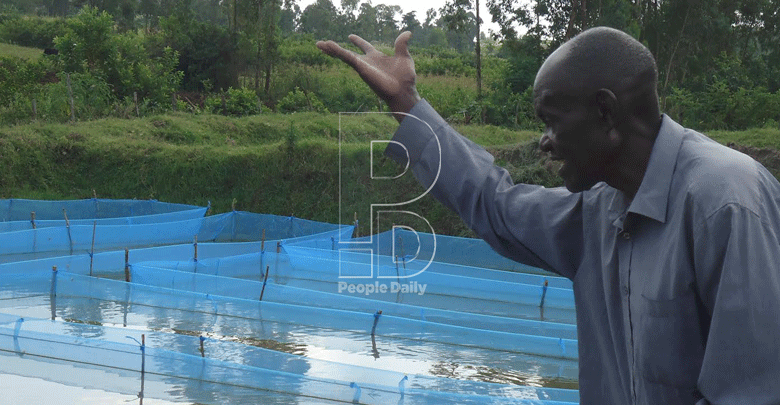Idle swampy land turned to profitable fingerlings hatchery

Hezron Oyanda’s farm in Osango village is at the forefront of promoting socio-economic change, majoring in production and nursing of the young fishes.
A 250-metre dusty murram road stretch off Oyugis-Rangwe-Rodi Kopany highway leads to Hezron Oyanda’s fish farm in Osango village in Rangwe sub-county, Homa Bay county.
Popularly known to the residents as Osewe Rabisa, the proprietor of Rabisa Enterprise Fish Farm, ventured in fingerlings production after being inspired by his farmer friend who was successfully running a fish hatchery project in the county.
This, coupled with guidance he got from agricultural officials, he was set to go.
The demand for quality fingerlings and their availability to farmers gave him confidence that the venture would earn him a decent living.
“When I started off in 2018, the farm would hatch between 3,000 and 6,000 fingerlings every production cycle.
This went all year round until 2019, where with sound mastery of the farming concept I progressively increased the production rate,” he recalls. 
Despite a few challenges at the inception, the agribusiness eventually broke even.
“The technical advice I got from agricultural experts enabled me to master the best practice for profitable fish farming,” he told Agribiz.
The farmer has found ways to utilise a huge part of his swampy land, thus turning to full-time fish farming.
Currently, the farm’s earnings from the enterprise range between Sh60,000 and Sh70,000 per month, with a bigger catchment area in Homa Bay, Migori, Kisumu, Kisii, Nyamira and Siaya counties.
With an average capacity of 1,400 brooders (fish reared for breeding purposes), Rabisa farm produces averagely 100,000 fingerlings every production cycle in a month.
Out of the brood stock, about 1,062 are females while the rest (354) are males.
He started with approximately 115 brooders acquired at Sh200 each before increasing his farm stock gradually.
Sitting on a total production area of 3,305 square metres, the three-acre farm has 11 earthen fish ponds comprising five for brooding stock and six for rearing fingerlings.
Out of the fingerling ponds, two are reserved for sex reversal and another four are for nursing the fries (juvenile fish about one to two centimetres in length), usually smaller than fingerlings.
The brooders’ ponds measure between 300 and 500 square metres while the fingerling ponds are 225 square metres.
The production process starts with collecting eggs from the brooding stock, which are taken to the hatchery ponds.
At this point, they take three to four days to hatch into fries (small hatchlings).
The eggs are harvested every 10 days, but sometimes they hatch into fries in the uppernets (brooder ponds) before they are collected.
The fries are then subjected to one month sex reversal process, put in nursing stage before finally hitting the market. Sex reversal helps minimise reproduction in the farmers ponds.
Keen attention must be paid to the period of collecting the eggs. The farmer says for the sex reversal to become effective, the eggs must not be assembled beyond the stipulated period as they might go past the monosex status.
“In the process of nursing, we can lose about 30 of them to predators and mortalities, leaving us with the actual production capacity of 70 per cent that goes to the market,” he says.
Improve genetic quality
The farm majorly sells at fries stage when juvenile fish attain between two grammes and five grammes live weight, when they are about one to one and half months old. Each goes for Sh5 at the local market,” Oyanda says.
His main clients are cage fish farmers, accounting for a bigger per centage of the farm sales.
Other buyers of his products are local fishpond farmers from Western Kenya and across the country.
“Much of the profits we plough back into the business to keep it afloat. This has seen us register steady growth in the past few years,” says the farmer.
The entrepreneur mainly sources the brood stock from Sagana National Fish Hatchery, Lake Basin Hatchery in Kibos, and Jewlet Fish Farm located in Karachuonyo sub-county.
“We intermarry the brooders sourced from different farms to improve their genetic quality.
The brood stock is replaced after two years to ensure production continuity,” says Oyanda, who is also the secretary of the Homa Bay County Fish Cooperative Society.
During the sex reversal the fries are fed eight times in a day. But this reduces at nursing stage when they feed six times in a day after a period of two weeks and in the following weeks they are introduced to four times weekly feeding mode.
On average, they consume two kilogrammes of sex reversal feed per week.
“The fries are fed according to body weight about five per cent of their body weight. The feed is increased until they attain the fingerlings stage,” he says.
Life turrned around
The proprietor is in the process of setting up an incubation system at his farm to facilitate the hatching of the fingerlings.
Similarly, as part of the expansion plans, he intends to construct 30 more ponds as he endeavors to increase his production in the next one year.
Oyanda says from the proceeds of fish farming, his lifestyle has turned around. He has educated his children from the business income, in addition to his day to day expenses.
The farm has employed two permanent staff and three part-time assistants. The farmer sees huge potential in fish farming in Homa Bay, saying the fact that a bigger part of Lake Victoria (about 70 per cent) falls in the county means that if it is well utilised in cage farming fish production stands to increase significantly.
He, however, points at the high cost of fish feeds and fish farming gargets as major challenges to the enterprise. A 25-kilogrammes bag of feeds goes at about Sh3,000 locally.



